Single-Shot Imaging of Two-Wavelength Spatial Phase-Shifting Interferometry
Abstract
:1. Introduction
2. Principle of Spatial Phase-Shifting Interferometry Using A Single Image of Polarization-Pixelated Camera (PCAM)
2.1. Spatial Phase-Shifting Interferometry Using A PCAM
2.2. Three-Color Interferometry Using A Color PCAM
2.3. Single-Shot Imaging of Two-Wavelength Interferometry
3. Results
4. Discussion
- —
- Coherent noise reduction and parasitic interference fringe;
- —
- Preliminary determination of fringe visibilities at λ1 and λ2.
5. Conclusions
Author Contributions
Funding
Conflicts of Interest
References
- Hocken, R.J.; Chakraborty, N.; Brown, C. Optical metrology of surfaces. CIRP Ann. 2005, 54, 169–183. [Google Scholar] [CrossRef]
- Kinnstaetter, K.; Lohmann, A.W.; Schwider, J.; Streibl, N. Accuracy of phase shifting interferometry. Appl. Opt. 1988, 27, 5082–5089. [Google Scholar] [CrossRef] [PubMed]
- Lai, G.; Yatagai, T. Generalized phase-shifting interferometry. JOSA A 1991, 8, 822–827. [Google Scholar] [CrossRef]
- Deck, L.; De Groot, P. High-speed noncontact profiler based on scanning white-light interferometry. Appl. Opt. 1994, 33, 7334–7338. [Google Scholar] [CrossRef] [PubMed]
- Park, H.M.; Jung, H.W.; Joo, K.-N. Dual low coherence scanning interferometry for rapid large step height and thickness measurements. Opt. Express 2016, 24, 28625–28632. [Google Scholar] [CrossRef] [PubMed]
- Dao, X.; Seta, K. High-accuracy absolute distance measurement by means of wavelength scanning heterodyne interferometry. Mean. Sci. Technol. 1998, 9, 1031. [Google Scholar] [CrossRef]
- Jiang, X.; Wang, K.; Gao, F.; Muhamedsalih, H. Fast surface measurement using wavelength scanning interferometry with compensation of environmental noise. Appl. Opt. 2010, 49, 2903–2909. [Google Scholar] [CrossRef]
- Cheng, Y.Y.; Wyant, J.C. Two-wavelength phase shifting interferometry. Appl. Opt. 1984, 23, 4539–4543. [Google Scholar] [CrossRef]
- Cheng, Y.Y.; Wyant, J.C. Multiple-wavelength phase-shifting interferometry. Appl. Opt. 1985, 24, 804–807. [Google Scholar] [CrossRef]
- Yamaguchi, I.; Ida, T.; Yokota, M.; Yamashita, K. Surface shape measurement by phase-shifting digital holography with a wavelength shift. Appl. Opt. 2006, 45, 7610–7616. [Google Scholar] [CrossRef]
- Parshall, D.; Kim, M.K. Digital holographic microscopy with dual-wavelength phase unwrapping. Appl. Opt. 2006, 45, 451–459. [Google Scholar] [CrossRef] [PubMed]
- Kühn, J.; Charrière, F.; Colomb, T.; Cuche, E.; Montfort, F.; Emery, Y.; Marquet, P.; Depeursinge, C. Axial sub-nanometer accuracy in digital holographic microscopy. Mean. Sci. Technol. 2008, 19, 074007. [Google Scholar] [CrossRef]
- Kühn, J.; Montfort, F.; Colomb, T.; Rappaz, B.; Moratal, C.; Pavillon, N.; Marquet, P.; Depeursinge, C. Submicrometer tomography of cells by multiple-wavelength digital holographic microscopy in reflection. Opt. Lett. 2009, 34, 653–655. [Google Scholar] [CrossRef] [PubMed]
- Fratz, M.; Beckmann, T.; Anders, J.; Bertz, A.; Bayer, M.; Gießler, T.; Nemeth, C.; Carl, D. Inline application of digital holography. Appl. Opt. 2019, 58, 120–126. [Google Scholar] [CrossRef]
- Zhang, Z.; Dong, F.; Cheng, T.; Qiu, K.; Zhang, Q.; Chu, W.; Wu, X. Nano-fabricated pixelated micropolarizer array for visible imaging polarimetry. Rev. Sci. Instrum. 2014, 85, 105002. [Google Scholar] [CrossRef]
- Yoneyama, S.; Kikuta, H.; Moriwaki, K. Simultaneous observation of phase-stepped photoelastic fringes using a pixelated microretarder array. Opt. Eng. 2006, 45, 083604. [Google Scholar] [CrossRef]
- Millerd, J.; Brock, N.; Hayes, J.; North-Morris, M.; Novak, M.; Wyant, J.C. Pixelated phase-mask dynamic interferometer. Proc. SPIE 2004, 5531, 304–314. [Google Scholar]
- Novak, M.; Millerd, J.; Brock, N.; North-Morris, M.; Hayes, J.; Wyant, J.C. Analysis of a micropolarizer array-based simultaneous phase-shifting interferometer. Appl. Opt. 2005, 44, 6861–6868. [Google Scholar] [CrossRef]
- Wang, D.; Liang, R. Simultaneous polarization Mirau interferometer based on pixelated polarization camera. Opt. Lett. 2016, 41, 41–44. [Google Scholar] [CrossRef]
- Kakue, T.; Yonesaka, R.; Tahara, T.; Awatsuji, Y.; Nishio, K.; Ura, S.; Kubota, T.; Matoba, O. High-speed phase imaging by parallel phase-shifting digital holography. Opt. Lett. 2011, 36, 4131–4133. [Google Scholar] [CrossRef]
- Jeon, J.W.; Jeong, H.W.; Jeong, H.B.; Joo, K.-N. High-speed polarized low coherence scanning interferometry based on spatial phase shifting. Appl. Opt. 2019, 58, 5360–5365. [Google Scholar] [CrossRef] [PubMed]
- Tian, X.; Tu, X.; Zhang, J.; Spires, O.; Brock, N.; Pau, S.; Liang, R. Snapshot multi-wavelength interference microscope. Opt. Express 2018, 26, 18279–18291. [Google Scholar] [CrossRef] [PubMed]
- Wang, D.; Tian, X.; Xu, P.; Liang, J.; Wu, H.; Spires, O.; Liang, R. Compact snapshot multiwavelength interferometer. Opt. Lett. 2019, 44, 4463–4466. [Google Scholar] [CrossRef] [PubMed]
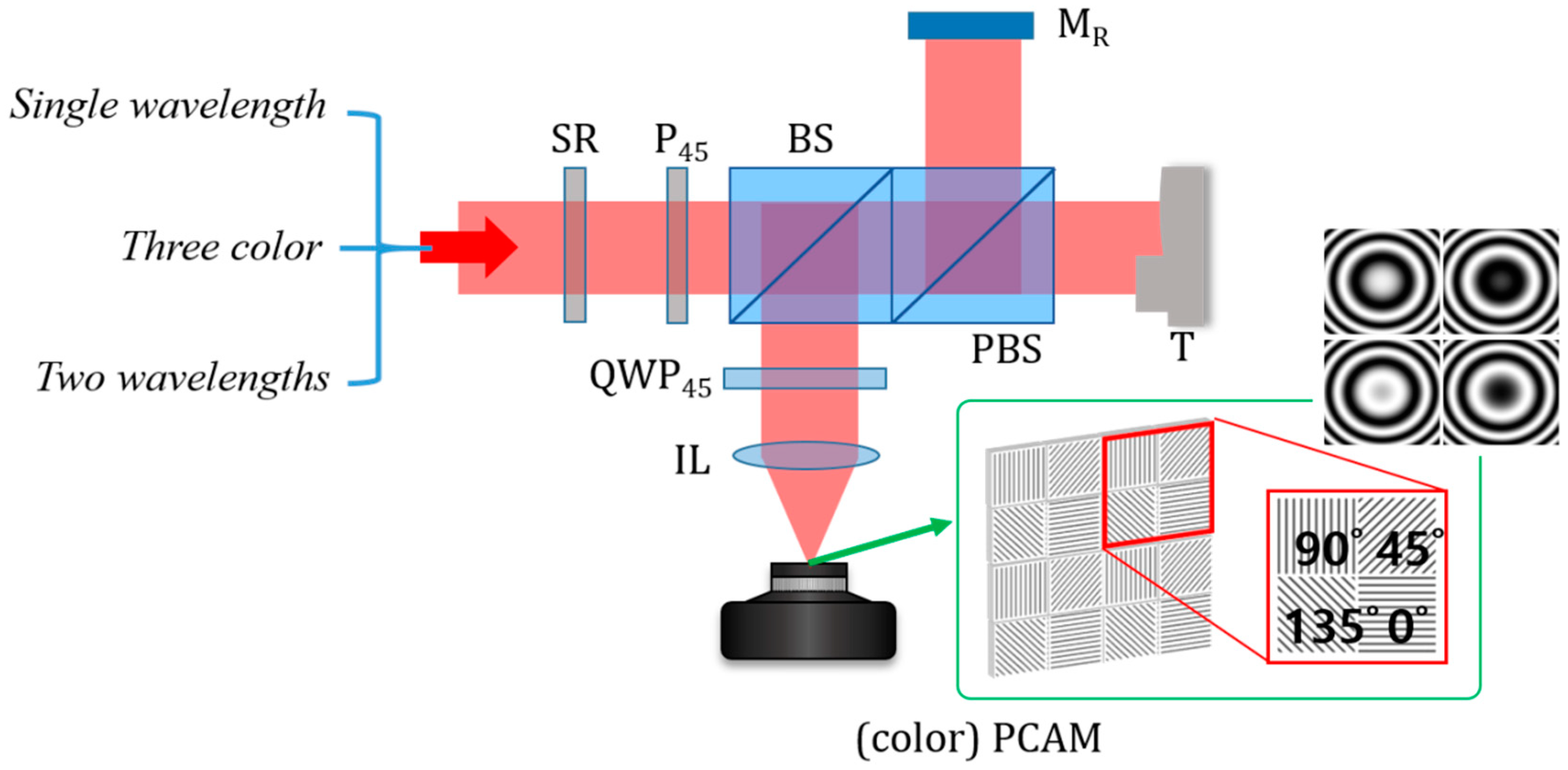
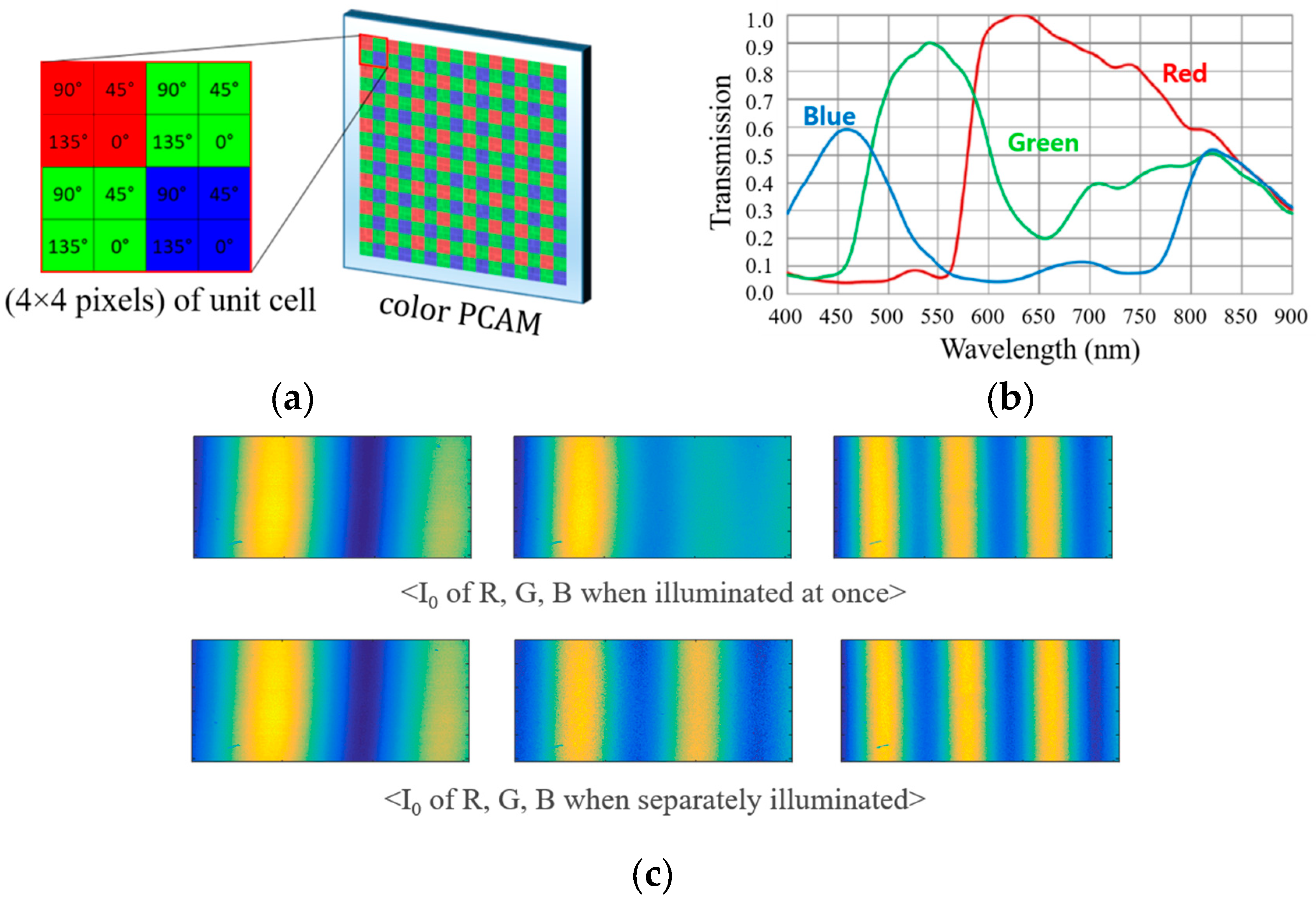
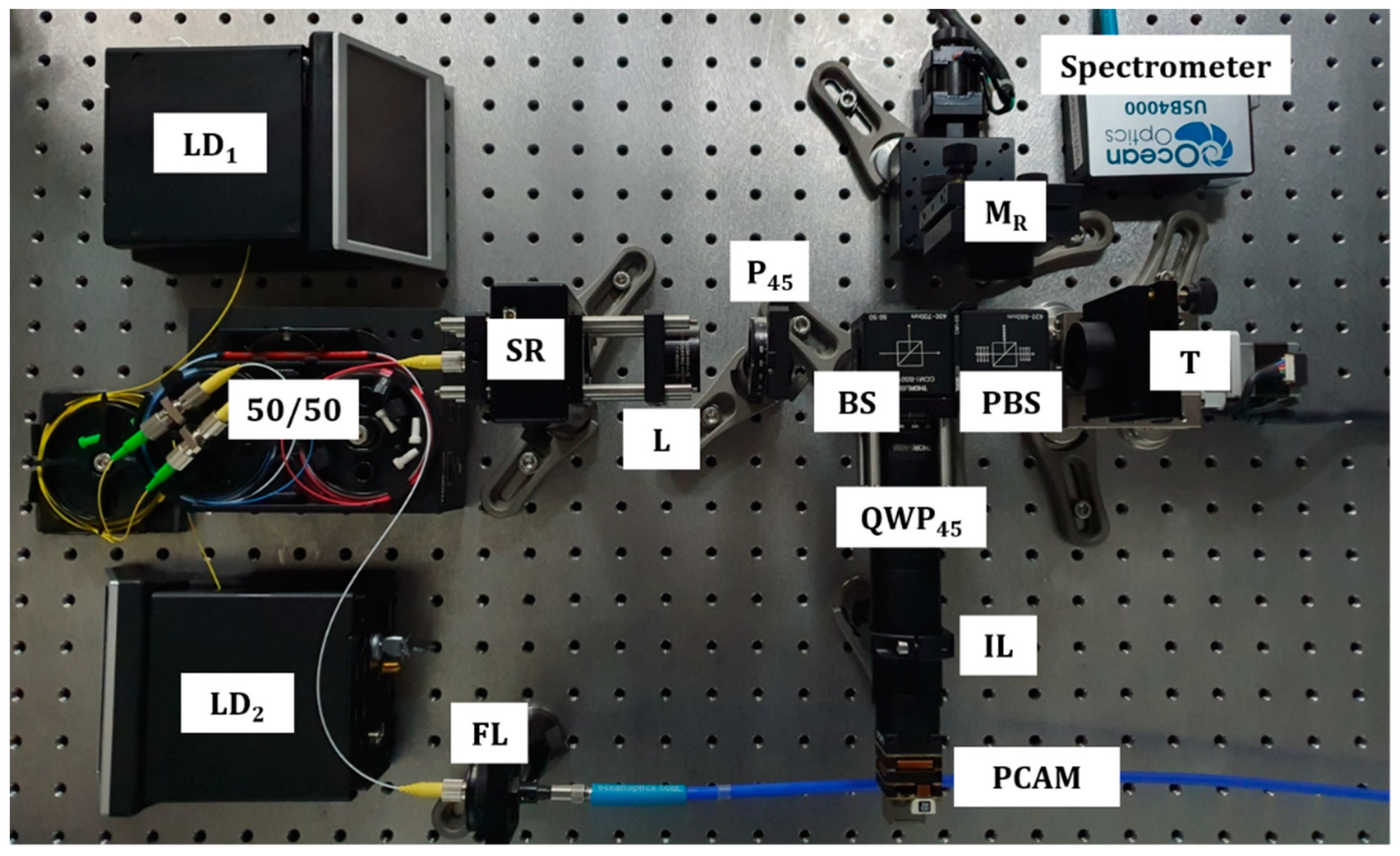
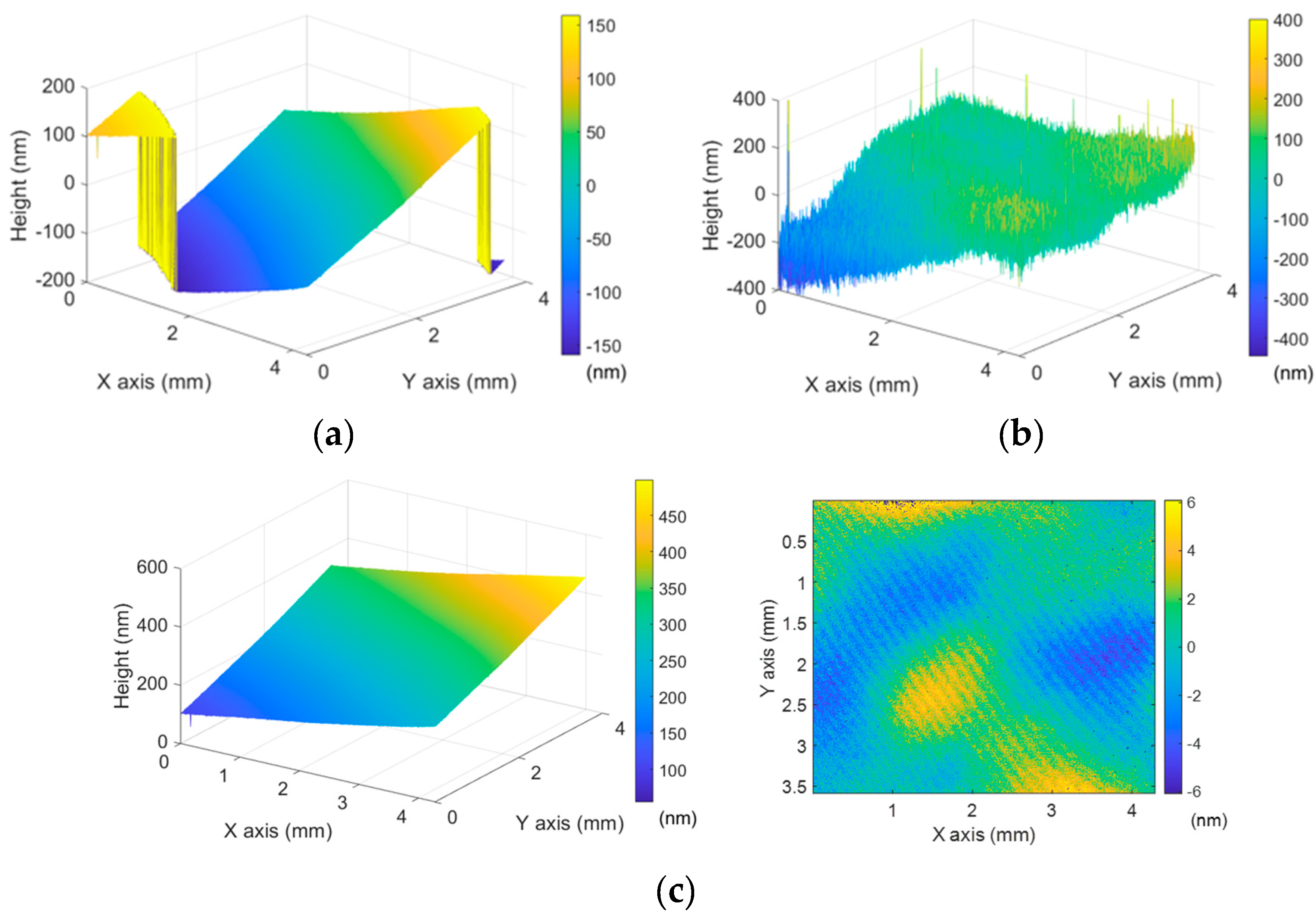
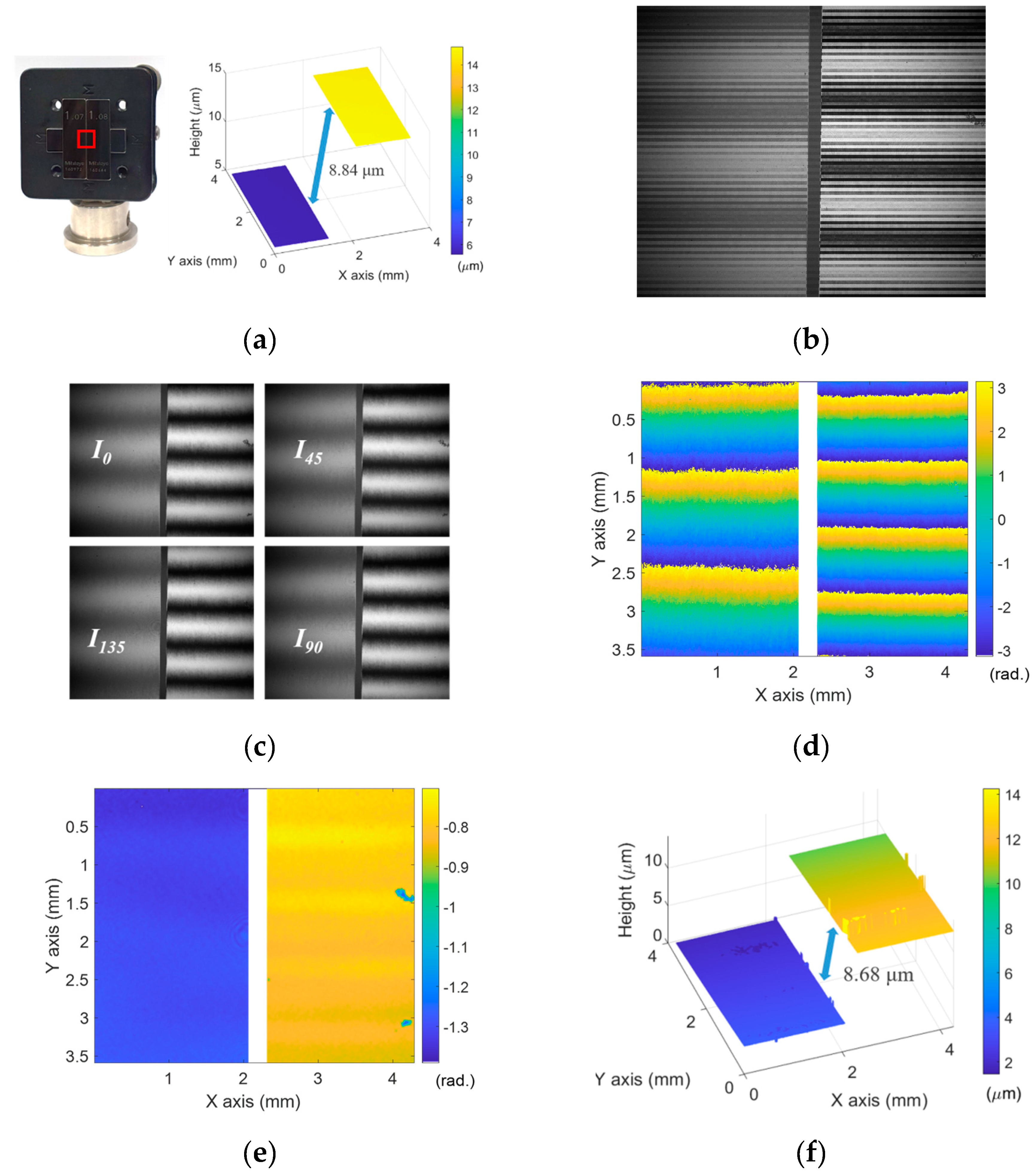
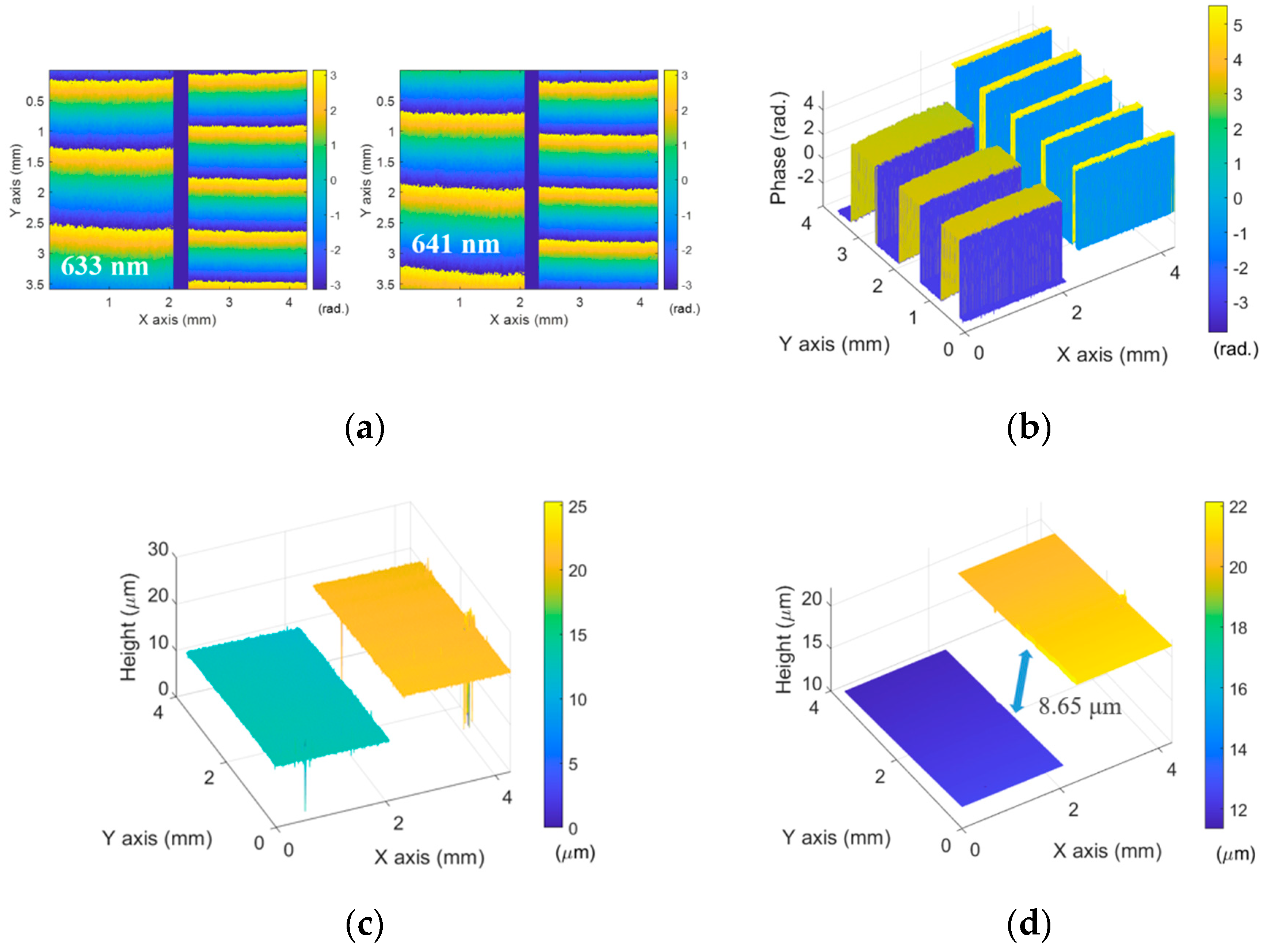
© 2019 by the authors. Licensee MDPI, Basel, Switzerland. This article is an open access article distributed under the terms and conditions of the Creative Commons Attribution (CC BY) license (http://creativecommons.org/licenses/by/4.0/).
Share and Cite
Jeon, J.W.; Joo, K.-N. Single-Shot Imaging of Two-Wavelength Spatial Phase-Shifting Interferometry. Sensors 2019, 19, 5094. https://doi.org/10.3390/s19235094
Jeon JW, Joo K-N. Single-Shot Imaging of Two-Wavelength Spatial Phase-Shifting Interferometry. Sensors. 2019; 19(23):5094. https://doi.org/10.3390/s19235094
Chicago/Turabian StyleJeon, Jun Woo, and Ki-Nam Joo. 2019. "Single-Shot Imaging of Two-Wavelength Spatial Phase-Shifting Interferometry" Sensors 19, no. 23: 5094. https://doi.org/10.3390/s19235094
APA StyleJeon, J. W., & Joo, K.-N. (2019). Single-Shot Imaging of Two-Wavelength Spatial Phase-Shifting Interferometry. Sensors, 19(23), 5094. https://doi.org/10.3390/s19235094




